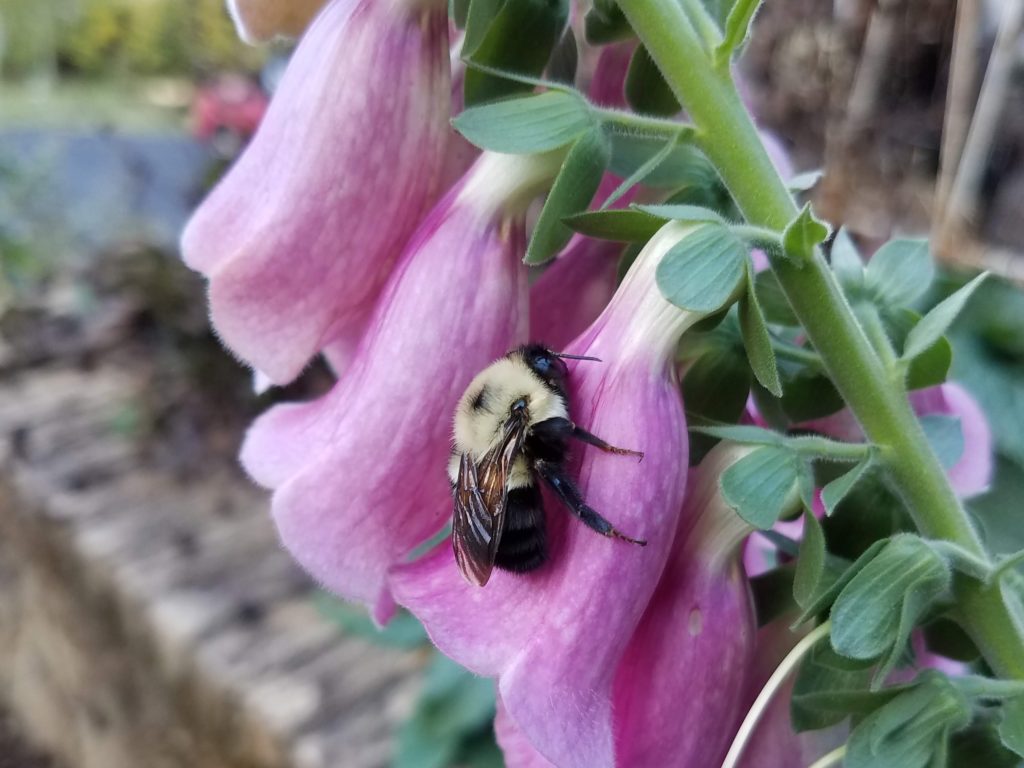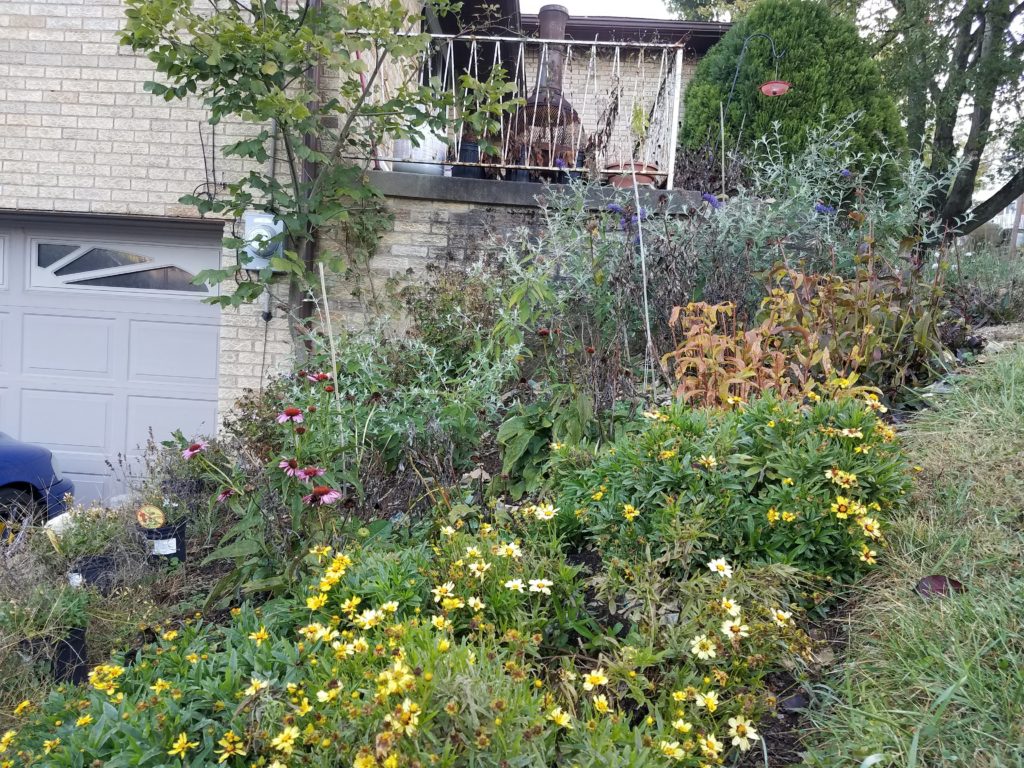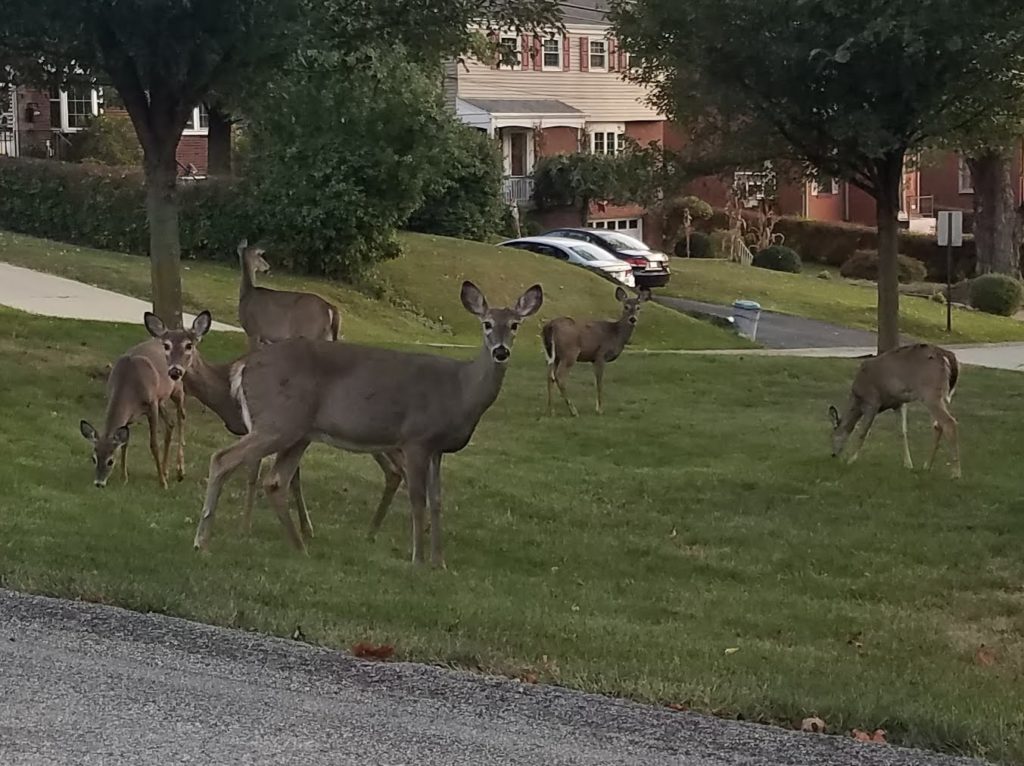It has been blissfully warm (and occasionally hot!) in Pittsburgh up until the last week or so. I have been thrilled that my garden has kept blooming long past when I expected it to. While I am still enjoying my flowers, I’ve already seen some of my neighbors bagging brush (not leaves – those aren’t down yet) for the garbage.
Given that, it seemed an appropriate time for a Fall Garden “Cleanup” post, as a companion to the one I wrote in the spring. In short, it is best to leave everything as it is so that your resident birds and insects can make use of it over the winter. While it may be difficult for you to leave your garden looking like a haunted house after Halloween is over, it will be better for your animal and insect guests.
Note: I am specifically focusing on my pollinator garden here. After reading this post, a friend of mine from college pointed out that he has a different process with different recommendations for his vegetable garden, and (without looking any deeper into the topic as of yet) I believe those differences likely come from what you’re trying to optimize: the health of your veggies or the health of your pollinators.
Stop Dead-Heading
I try to keep on top of dead-heading my perennials all summer. Typically I’ll take a morning every week to go around the garden and cut back spent blooms so the plant will use its energy creating new flowers for my bees, butterflies, and hummingbirds. By the time the first day of fall rolls around, I’ve usually run out of time to do this as religiously as I did in the spring and summer, but I can justify that laziness with the fact that it’s better for the plants too.
Once the weather starts to turn, you can simply leave the spent blooms on the plant. In a guide on pruning roses, we see that deadheading “pushes sap up into the outer, most tender branches… A sudden freeze could freeze the sap. When liquids freeze they expand and this literally blows the rose apart from within by the freezing sap rupturing the cell walls. In fall roses instinctively send their sap down into the roots so there is no danger of that. Deadheading interferes with that process and you run the risk of damaging the roses.”[1]
Leaving the spent blooms in place also provides food for birds during the winter. I won’t lie: looking at the stiff, withered stalks from my Echinacea and Black-Eyed Susans makes me feel like a bad gardener. It has taken me some getting used to, but if it means more food for the birds and less work for me, I’m less likely to object.

Don’t Clear Brush
Some of my neighbors have already started cutting back ornamental grasses and clearing out their garden beds. Again, it is best to leave brush and stalks from plants in place until late in the spring. Some species of insects, including some bees, deposit eggs inside old plant stalks, and they will emerge in the spring. If you clear away those stalks either in the fall or in the spring before the weather is warm enough, you are literally throwing away another generation of beneficial insects.[2] This spring was my first year following that advice, and I think I noticed a greater quantity and variety of insects in my garden.
Similarly, there are ground-dwelling insects that benefit from leaves, dead brush, and the remnants of this year’s annuals. Leaving that detritus in place until spring will provide shelter for insects and for some birds too. Remember to leave it in place as late in the season as you can, ideally until temperatures are reliably in the 40s overnight.
If you absolutely must clean up your garden for appearances and to avoid the judgement of your neighbors, try just tidying up the front yard and leaving the back yard as it is. Sustainability is not an all-or-nothing decision, but rather about finding what changes work for you. Half-measures are far better than nothing.

Fall Planting
You can plant perennials until the ground freezes, which is fortunate for me because I still have some impulse purchases from summer sitting on my porch. Fall is a great time for planting perennials, shrubs, bulbs, and even clover (if you do it early enough – you want to leave a good six weeks before the first heavy frost).[3]
In the case of random early frost warnings, you can protect your plants from an unexpected overnight cold snap by covering them with bedsheets.[4] I remember helping my mom when I was a kid – if we would hear on the news that a frost was expected overnight, we would run outside with sheets and spread them over the plants that were still flowering and the herbs that hadn’t been picked yet (particularly mounds of basil that would become pesto).
As for feeding your plants, fall is not the time for inorganic or synthetic fertilizers. (There is never a time for inorganic fertilizers, in my yard, but that’s my preference.) “Organic fertilizers work over time to create a healthy growing environment, while inorganic fertilizers provide rapid nutrition,” according to HomeGuides.[5] Fall is the time to build nutrients in the soil, not force plants into an additional growth period. Organic fertilizers take time to work, so fall is a good time to start building up the soil.
Similarly with the lawn – if you fertilize your lawn – early fall is the time to put down a layer of low-nitrogen, slow-release fertilizer like Milorganite.[6] Christian was shocked the first time I brought home a sufficient quantity of organic fertilizer for our yard because it was orders of magnitude larger in size than the synthetic fertilizer he typically purchased. That being said, it worked fine, and he hasn’t used synthetic fertilizer since. As an added bonus, our deer hate the smell of Milorganite, so they stay away for a while after we apply it.

It may be difficult to restrain yourself, but the less you do to your garden this fall, the better. Transitioning from a perfectly-manicured look to a natural look may take some adjustment, but it will be worth it as you build a healthy ecosystem in your yard.
Do you have any helpful gardening tips or practices that you use at home? I’d love to hear about them below.
Thanks for reading!
[1] https://www.finegardening.com/article/another-fall-tip-stop-deadheading
[2] https://phys.org/news/2018-09-pollinators-easy-fall-garden-cleanup.html
[3] https://www.outsidepride.com/seed/clover-seed/Clover-Seed-Planting-Instructions/
[4] https://www.gardeningknowhow.com/plant-problems/environmental/protect-plants-in-freeze.htm
[5] https://homeguides.sfgate.com/inorganic-fertilizer-vs-organic-fertilizer-39528.html
[6] https://www.milorganite.com/lawn-care/seasonal-lawn-tips/fall-lawn-care/fall-lawn-care-tips
2 Comments
Galen · November 16, 2019 at 8:48 pm
You’re enabling my laziness.
Alison · November 17, 2019 at 10:08 am
That’s what I’m here for!